The IoT provides a quick way to access and connect devices and applications at scale around the globe.
Not only does the IoT help to boost productivity and efficiency for businesses, but it also streamlines homes and cities for more convenience and environmental sustainability.
If you’re asking, “What is IoT?” then you’re in the right place. This guide explains how the Internet of Things works, why it’s important, its pros and cons, and aspects of its security.
What Is IoT? The IoT Explained
So, what is IoT, and how does it work?
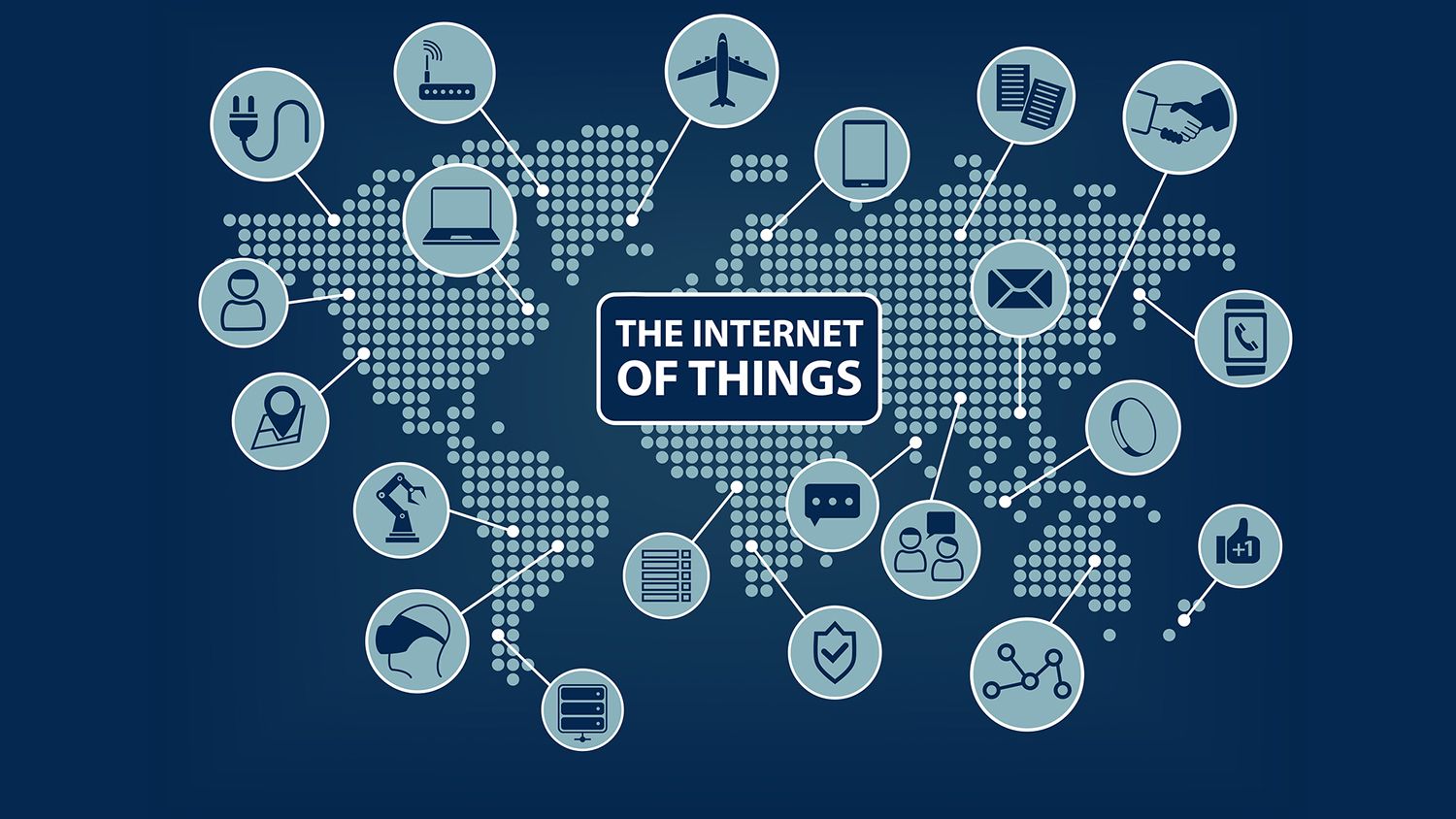
The Internet of Things, abbreviated to IoT, is an interconnected network of physical devices (computers, sensors, and machinery) and software (applications) that work together to automate and streamline processes.
This network exchanges information and commands across the internet, collecting, recording, and managing data to power the functionality of connected devices.
These devices and applications include everyday tools, like your FitBit or Amazon Dot. They can also be industry-level systems, such as manufacturing equipment or broad-scale sensors.
What Are IoT Applications?
An IoT application is software that runs on IoT-enabled devices.
All kinds of applications exist across every industry sector, from healthcare to civil engineering to residential heating.
These applications can give you remote control of your sensor technology to help you manage collected data and streamline workflows.
An IoT application provides a dynamic solution to operating your IoT smart devices using artificial intelligence (AI) and machine learning to enhance data collection and automate processes.
You’ll find IoT apps that help individuals and businesses to:
- Simplify processes
- Improve behavior and performance
- Automate tasks
- Set environmental conditions
- Monitor and control activity
- Cut costs and track profit and loss
What Is Industrial IoT?
“Industrial IoT” refers to IoT solutions designed for industrial settings, such as warehouses, factories, and manufacturing plants.
These environments require complex communication between devices to streamline and automate industrial processes.
Not only do industrial IoT applications help industrial settings remotely communicate between devices, but they can also help teams check for:
- The quality, efficiency, and effectiveness of physical machinery parts and mechanical workflows
- The efficiency and productivity of processes and systems
- Manufacturing and processing costs and wastage
How Big Is the IoT?
By 2019, 10 billion devices were connected to the IoT. By 2025, predictions estimate that there will be close to 40 billion.
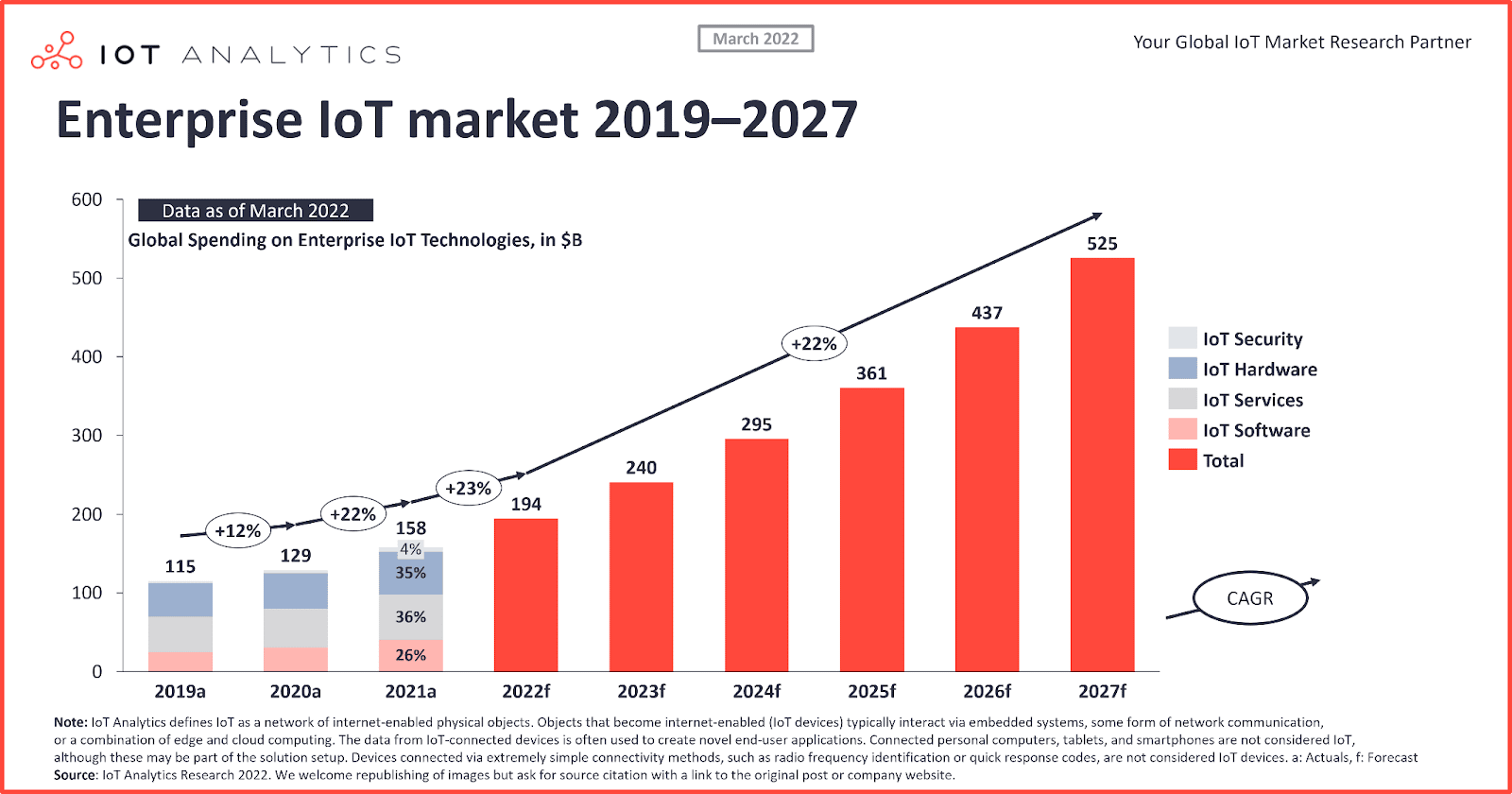
The global IoT market, which grew by 22% in 2021, is currently valued at $384.70 billion.
Why Is the IoT Important?
For individuals and households, the IoT provides an easy way to connect everyday devices, such as your Apple Watch or smart thermostat.
By connecting people and services globally, the IoT makes it easier to automate everyday tasks and take control of behaviors.
By harnessing IoT apps and devices, consumers can monitor their usage of services and products to manage their lifestyle and home costs and alter their habits accordingly.
For industry, the IoT collects data to monitor efficiency, efficacy, and productivity in manufacturing and delivery processes.
Not only does this streamline manufacturing and maintenance, but it also provides a diagnostics system for disaster management.
But it’s not just what the Internet of Things can do that makes it important — it’s how it does it.
The IoT provides an affordable way to connect and automate devices. It’s not just the internet that’s cheap. You can also pick up IoT apps and devices for pretty low prices.
Plus, thanks to intuitive interfaces and smart devices, the IoT is easily accessible. It’s simple to learn new software.
On top of that, the IoT facilitates global remote working. Individuals and businesses can access their applications from devices anywhere in the world.
This enables you to adjust conditions immediately from anywhere based on real-time data.
In short, the Internet of Things enables the physical world to meet the digital world to accelerate and automate activities. That way, you reduce manual work and human error while enhancing workflows and behaviors.
How Does the IoT Work?
The Internet of Things comprises four synchronized components: sensors, connectivity, data processing, and a user interface.
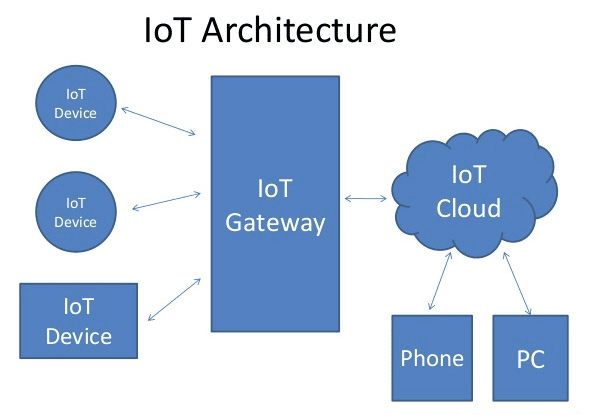
Sensor technology. Sensors enable you to collect data from your environment.
This could be as simple as a motion sensor detecting movement in your home or as complex as voice recognition software for voice-to-text applications.
Connectivity. This part of the process provides sensors with a gateway to the cloud via the internet. This enables devices to send data to the cloud for processing.
Connectivity options include WiFi, Bluetooth, cellular, satellite, low-power wide-area networks (LPWANs), and ethernet. Your choice depends on your power consumption, bandwidth requirements, and range.
Data processing. In the data processing stage of the IoT, an application will automatically collect, manage, and store data based on set parameters.
On a simple level, this could be the process of collecting and validating temperature readings from a soil thermometer.
On a more complex level, this could be the collection, recognition, and translation of voice messages.
User interface. The user interface makes data readable to humans. An intuitive interface will also enable you to check and respond to the data in real time.
You can change the way the data looks, change the way sensors operate, create alerts about incoming data, and share data with other devices and apps.
Example IoT Applications and Devices
Internet of Things applications run on IoT devices. Working together, they provide automated functionality across a plethora of settings.
As Calvin Hendryx-Parker, Chief Technical Officer of Six Feet Up, puts it:
“From genetic engineering to crop management and space exploration, every day, developers implement impactful innovations that benefit humankind.”
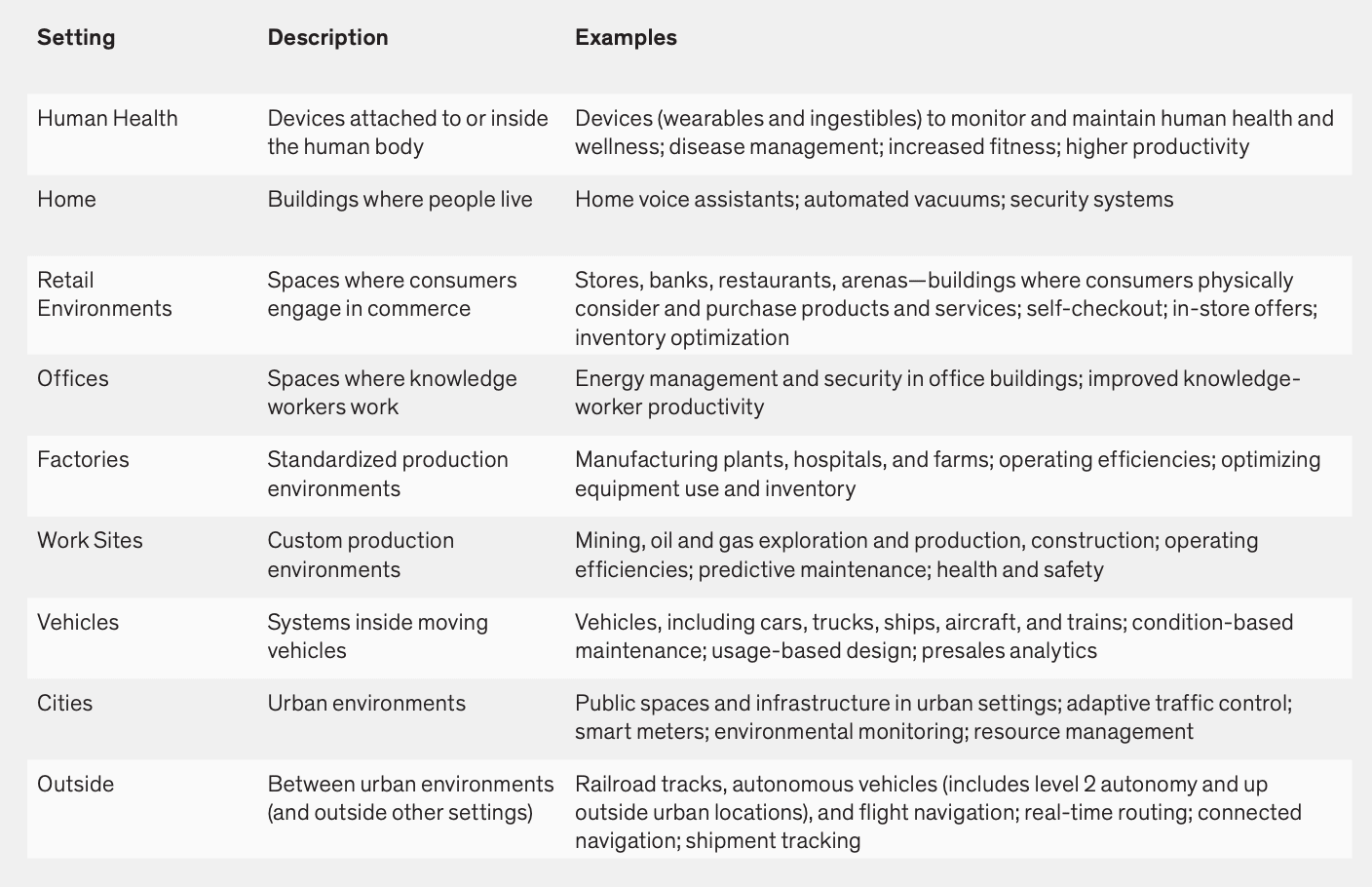
Let’s jump into some examples.
Smart homes. Smart lighting has devices such as smart light bulbs and sensors for ambient intelligence — lighting that’s responsive to movement. These devices are operated from a smartphone app.
Wearables. Your Apple Watch or FitBit is an example of a wearable device with an IoT app to function and connect to operational applications on your smartphone or tablet.
Transport. On a basic level, your car key fob works as an IoT device, connecting to applications that enable you to lock your car, pop the trunk, and set the alarm.
On a more complex level, self-driving cars use the IoT for refueling. A fuel gauge sensor sends a refueling warning to the car’s internal management app. The car’s system automatically sends a signal to find nearby charging points.
Available charging points respond, triggering the car to drive autonomously to the charging port. In this example, the fuel sensor, car, and charging port are IoT devices, while the car’s internal system and charging port software are applications.
Business. If you need website development tools, your MacBook, iPhone, or tablet will work as a device. Software like DevKinsta functions as your development application. Alternatively, if you’re monitoring performance, you might use the Kinsta APM tool as your application.
If you need to track assets, you might have a tracking device attached to delivery trucks, a tablet for drivers to record drop-offs, and a computer to manage all deliveries. The tracker, tablet, and computer all run IoT apps.
Smart cities. Smart bins use weight sensors to signal to refuse trucks that they need emptying. Both the sensors and the on-truck computer run applications to manage this process. This streamlines city waste management.

Smart parking meters make it easier to pay for parking on your smartphone. Traffic wardens carry devices to run payment checks. The meter, your smartphone, and the traffic warden’s device run applications that all link together.
Pros and Cons of the IoT
The IoT allows you to digitally transform your home and business. However, there are a few hurdles you will face when designing your applications and devices network.
Benefits of the IoT
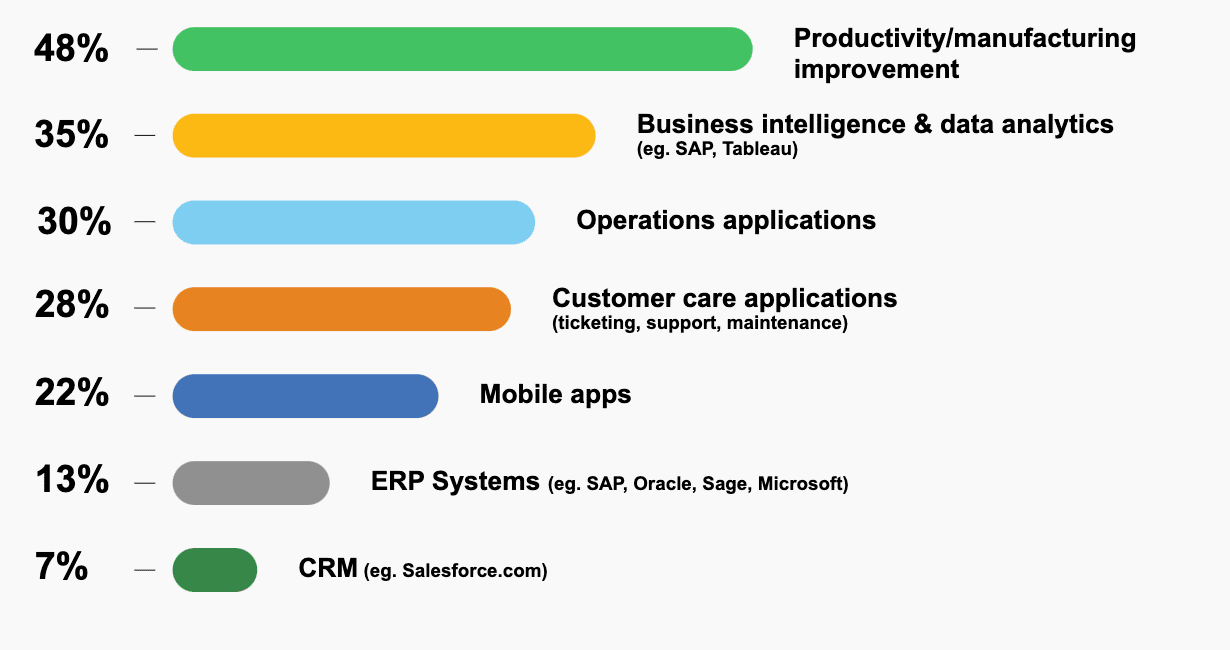
The benefits of the IoT are enormous:
Efficiency and productivity. 48% of companies claim that the IoT brings the most value by improving productivity and manufacturing output. This shows that automation boosts efficiency and productivity.
Resource conservation. Monitoring, management, and automation help conserve resources like time, money, assets, and human effort.
Behavior enhancement. You can figure out how and where to improve behaviors by monitoring and tracking activities.
Communication. The connections between devices improve communication capabilities. The IoT is easy to access thanks to cheap devices and intuitive interfaces.
Environmental impact. Combining behavior tracking with automation helps us influence systems toward eco-friendly work. According to John Canali, Principal Analyst at Omdia, “IoT provides enterprises with the tools not only to commit to environmentally sustainable practices but to turn these efforts into profits and savings.”
Scalability. Device and application automation enable you to scale systems affordably.
Business intelligence. The IoT gives you insight into how your customers use and respond to your products and how your team collaborates effectively. That way, you can devise business strategies based on positive behaviors.
Business evolution. The IoT provides a route to business evolution, helping you to access new product lines and enter new markets.
Drawbacks of the IoT
Here are some of the main reasons that the Internet of Things doesn’t always perform perfectly:
Tracking and privacy. Apps gather data and track behaviors. This poses questions about who should access that data, how it should be shared, where it should be stored, and when it should be deleted.
Without a clear data policy, your business can run into safeguarding issues — with breaches resulting in big non-compliance fines. This could mean users’ personal data is exposed to malicious sources.
However, despite the demand for data-privacy policies, only one in ten businesses recognize the need for this as a way to accelerate IoT solutions.
Security issues. Security concerns have become paramount with many devices and applications connected to the internet.
There are many points of entry for spyware and viruses to corrupt data, steal information, and take control of devices.
Bandwidth. You’ll struggle to operate your IoT devices and applications without enough bandwidth.
Energy costs. Running and charging lots of devices can drain electricity, contributing to higher power bills when the energy cost is already increasing.
Compatibility. With so many devices and applications, it’s important to consider compatibility within your network, and with external networks (other companies) you may want to connect with.
Employment shifts. Automation and AI reduce the demand for manual, repetitive work. This could mean fewer factory conveyor belt workers for manual tasks or fewer HR or accountancy admin workers to manually input data.
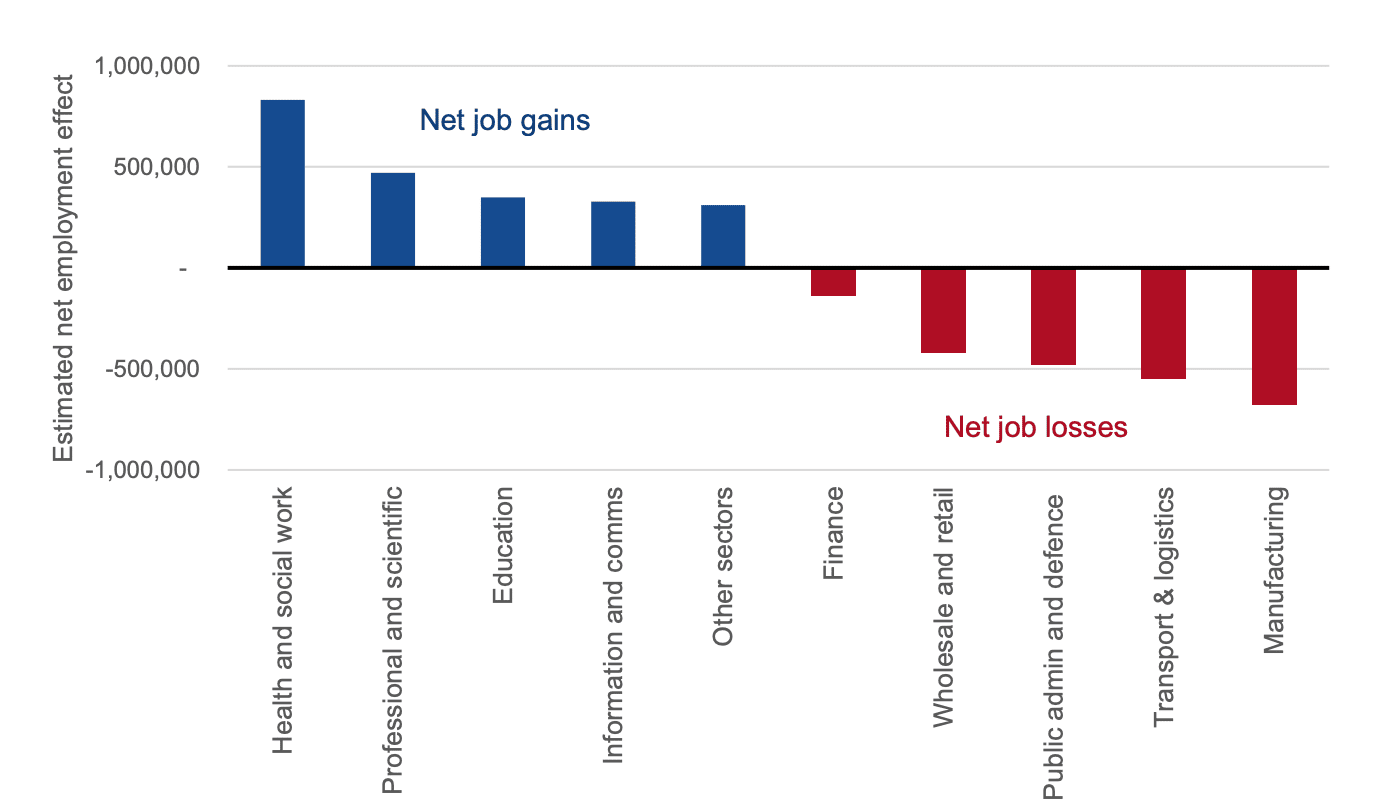
While certain job positions may be lost, the IoT opens up new job opportunities within technology and data analysis in the education, healthcare, social work, professional, and scientific fields.
Growing IT budgets. More technology means bigger IT budgets for both businesses and the home. Not only do commercial entities have to budget for more software and bigger technology teams, but consumers may have to pay for tablets, wearables, self-driving cars, etc.
Reliability. If you don’t have good network reliability combined with solid apps and high-quality devices, you’ll experience downtime. This can affect communication and product performance across an entire business.
IoT Standards and Frameworks
IoT standards and frameworks define how systems are developed to ensure compatibility, accountability, and reliability across the whole network.
IoT Standards Explained
Functioning a little like an operating system, standards are the established protocols that IoT apps run on.
The purpose of standardization is to establish universally accepted methods of creating applications and devices. That way, developers have interoperability across the network.
Standards improve compatibility and interoperability, enabling systems and entities to work together across a network.
With solid standards in place, different industries and markets can collaborate using IoT applications to facilitate innovation. However, without sound standards, companies can’t easily share data and information.
IoT standards also enhance IoT security systems. With universally accepted security standards, it’s more straightforward to protect everyone within the network.
Here are four examples of popular standards:
- IPv6 over Low-Power Wireless Personal Area Networks (6LoWPAN)
- ZigBee
- The Data Distribution Service (DDS)
- LiteOS
IoT Frameworks Explained
IoT frameworks are the platforms that support the development, management, and performance of applications, allowing for the smooth exchange of data across devices and applications.
As a middleware layer, frameworks provide ecosystems for devices and applications to connect to. For example, all IoT setups require cloud computing services to collect, process, and store sensor data. Microsoft Azure and Amazon Web Services are frameworks that provide such services.
Examples of well-known frameworks include:
- Amazon Web Services (AWS) IoT
- Microsoft’s Azure IoT Suite
- Brillo/Weave by Google
- Calvin
IoT Privacy and Security
Regarding security, with many devices attached to the network, you have many points of entry for malicious sources. Each device that’s added creates a new entry point.
Keeping tabs on the security of every device is extremely difficult, with cheaply made devices readily available all over the world. A hacker only has to bypass one shoddy device to get in.
But it’s not just the security of devices and applications that businesses have to worry about. Not all consumers are conscious of security. All it takes is for one hacker to guess one person’s password, and they can enter the system.
And for the whole system to be secure, security measures are needed at every level: sensors, connectivity, data processing, and user interfaces.

Businesses need solid solutions to manage security risks, as they cannot rely on consumers being responsible when purchasing devices.
On top of that, companies aren’t ready to handle this influx of data. Not only do most businesses fail to understand the need, but many teams also lack the skill set to set up even basic security measures. In some cases, businesses don’t even think about security or don’t have the budget for it.
Potential privacy problems related to the collection, storage, and sharing of data also exist.
The IoT collects data on both who people are — demographics — and what they do — behavior. There needs to be rules and regulations that govern how consent is given for use, how this data is used, and how companies stay compliant.
The main privacy concerns include:
Eavesdropping. Malicious sources snoop on people’s private lives by, for instance, hacking security cameras or baby monitors.
Public exposure. Companies share or sell data that consumers don’t think about without their explicit consent, such as a car hire company selling driving data to insurance companies.
Data breaches. Hackers access payment and contact details by entering devices, applications, or servers.
Cheap devices. Poor security measures on cheap devices make it easy for spyware to enter the system.
Accountability. It’s unclear who is responsible for a breach when a hacker enters via a device or application, especially if it’s a password breach.
The IoT and the Cloud
The cloud refers to a huge network that supports IoT devices and applications.
When someone says they’re “uploading something to the cloud,” they’re talking about the internet, of course — but specifically a hub on the internet.
If the internet is the sky, the cloud is, well, a cloud.
And just like a cloud goes through a cycle of activities, so does cloud computing.
The internet runs with data stored on edge servers. These servers are physical things owned and managed by companies. These companies provide applications that collect, process, and store data. There’s also an online interface to manage and view that data.
Cloud computing is a centralized system comprising server management, the data processing layer, and the online interface customers use.
When someone says they’re uploading something to “the cloud,” they might mean Google Cloud.
When you upload something to Google Cloud, it goes to Google’s server. Google manages and stores that data. It shows up in your Google Drive, where you can store, read, collaborate on, and share it.
Why Cloud Computing is Important for IoT
The cloud tier provides the data-processing layer of the IoT. Once data is collected from the sensors, it goes to the cloud for processing.
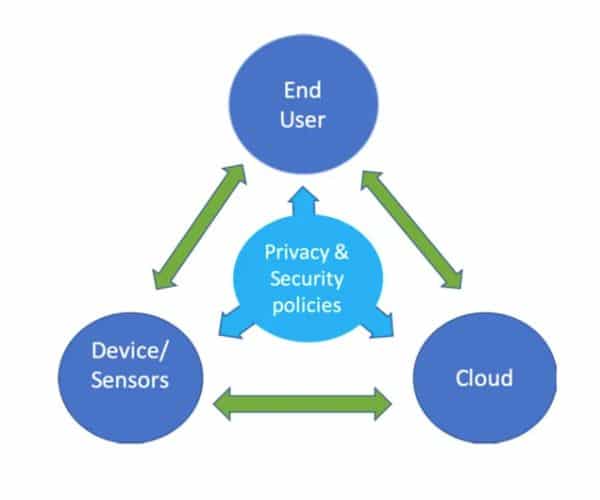
Many devices and data types are used for different purposes, from VR glasses to surgical training equipment and fitness trackers.
All of these devices need cloud solutions that store, manage, and secure this data at scale.
Accessibility to information needs to be flexible, reliable, and universal, and there needs to be a way to share, communicate, and collaborate on data. And it needs to happen at speed.
Plus, disaster recovery mechanisms are imperative within your cloud solution, as they prevent data from being lost or corrupted.
Cloud IoT core computing provides scalable encrypted services that collect, store, protect, and manage data in this way for IoT devices and applications.
The 4 Types of Cloud Computing and IoT
There are four types of cloud computing: Infrastructure as a Service (IaaS), Platform as a Service (PaaS), Software as a Service (SaaS), and Everything as a Service (EaaS).
Infrastructure as a Service (IaaS). Using the internet, IaaS gives you on-demand service to technology infrastructure and resources, such as dedicated hardware, networking capabilities, and storage.
Platform as a Service (PaaS). Most often used for app development, PaaS gives you hardware and software that work together so that you can build tools. PaaS includes databases, middleware, operating systems, and servers.
Software as a Service (SaaS). A completed software tool, SaaS provides end-user applications that work on the IoT. This could be a web-based customer relationship management (CRM) solution, an accounting tool, or a music-streaming service.
Everything as a Service (EaaS). Encompassing the vast web of products, tools, and services accessible on the IoT, EaaS refers to all emerging technology groups. These include Desktop as a Service (DaaS) and Artificial Intelligence as a Service (AIaaS).
Data and the IoT
The IoT collects and processes an incredible amount of data in all shapes and sizes. Data management is, therefore, fundamental to a secure, smooth-running system.
For small businesses, you may only have to manage the data from your website. You may have an online store that collects email addresses, customer names, and payment details. A tool like MyKinsta can help you collect, manage, and store this data.
However, if you’re a large organization, you may need a Big Data solution. Big Data refers to enormous sets of data that can’t be handled by traditional databases.
Big Data solutions work on the IoT to:
- Enable real-time collection and analysis of a variety of data at volume and speed
- Store lots of data in Big Data databases using tools like Spark
- Create and share data reports
Summary
To answer the question, “What is IoT?” think of it like Willy Wonka’s factory for global connectivity, automation, and innovation.
Think of any way that you could improve something by automating it, collecting data on it, or connecting it to something else. The IoT can help with that.
But it’s important to understand the IoT’s setbacks in its current state. Security and privacy are major aspects to consider. Large amounts of data need to be protected, and it’s your neck on the line if that doesn’t happen.
IoT holds the key to smarter living, working, and evolution for businesses, homes, industries, and cities. That’s why it needs careful planning and thought.
Get started by managing your websites efficiently and smartly with MyKinsta.



